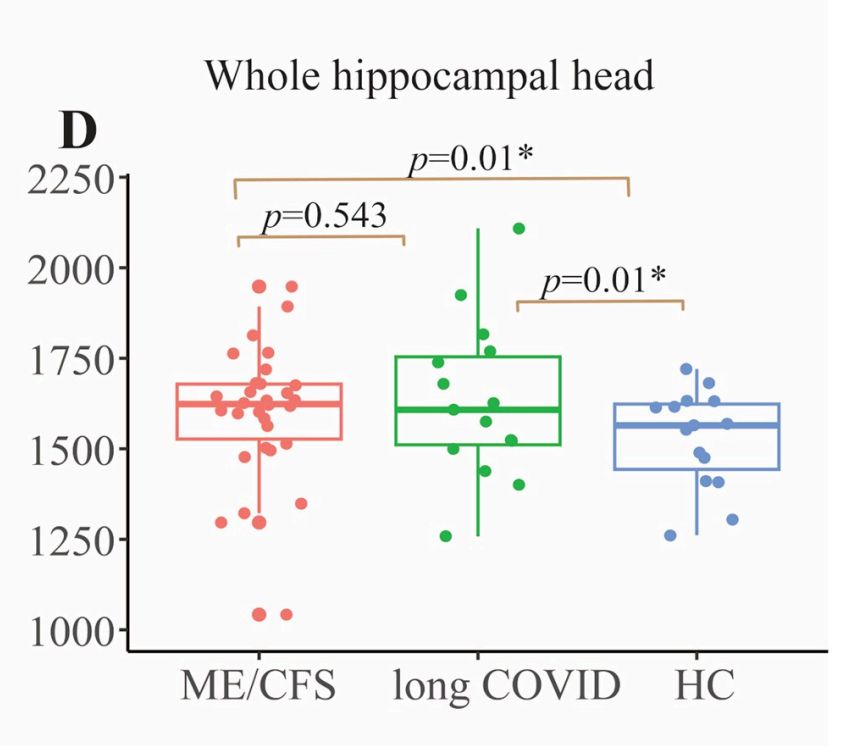ME/CFS research
@cfsresearch.bsky.social
Interested in research into ME/CFS/MECFS, FND and related conditions. https://medium.com/@cfs_research
This is one of the few studies which compares ME/CFS and longcovid patients to controls. Unfortunately they didn't find any difference in HR between groups in the head-up tilt test.

October 16, 2025 at 12:47 AM
This is one of the few studies which compares ME/CFS and longcovid patients to controls. Unfortunately they didn't find any difference in HR between groups in the head-up tilt test.
s4me isn't really the best place to discuss science...it can be a bit of an aggressive echo chamber. bsky is much better. As for this theory: the problem is that studies that look at mitochdrondrial respiration haven't found any difference between LC patients and bedrest controls.

September 11, 2025 at 1:09 AM
s4me isn't really the best place to discuss science...it can be a bit of an aggressive echo chamber. bsky is much better. As for this theory: the problem is that studies that look at mitochdrondrial respiration haven't found any difference between LC patients and bedrest controls.
You can see in the figure (which isn't likely to change).

August 22, 2025 at 3:15 PM
You can see in the figure (which isn't likely to change).
reasonable to expect a hospital to keep the patients until they are 100% recovered.

July 25, 2025 at 8:05 PM
reasonable to expect a hospital to keep the patients until they are 100% recovered.
Pretty terrible media article (as usual). The study itself even says that it can't be used as a biomarker. All the elevated values only affect a very small percentage of patients, but they reach statistical significance due to the large sample size.

June 21, 2025 at 9:16 PM
Pretty terrible media article (as usual). The study itself even says that it can't be used as a biomarker. All the elevated values only affect a very small percentage of patients, but they reach statistical significance due to the large sample size.
The recent Keller CPET study found no significant differences between patients and sedendary controls: 61% of controls had a reductions in VO2 on day2 compared to 64% of patients (at AT), and it was similar for work rate (which was the previously well replicated result).

May 16, 2025 at 4:31 AM
The recent Keller CPET study found no significant differences between patients and sedendary controls: 61% of controls had a reductions in VO2 on day2 compared to 64% of patients (at AT), and it was similar for work rate (which was the previously well replicated result).
Also, the OXPHOS and SDH were similar in ME and long covid to post-bed-rest patients.

May 7, 2025 at 3:52 AM
Also, the OXPHOS and SDH were similar in ME and long covid to post-bed-rest patients.
Looks like the control group just has unusual %s of muscle fibres, as the bed rest group has similar %s to ME and long covid groups.

May 7, 2025 at 1:40 AM
Looks like the control group just has unusual %s of muscle fibres, as the bed rest group has similar %s to ME and long covid groups.
Sorry, table got cut off:

April 10, 2025 at 4:50 AM
Sorry, table got cut off:
From another study: pmc.ncbi.nlm.nih.gov/articles/PMC... i.e. LC patients have higher volume in SCP vs lower, and if you look at the HC values (217.1mm), it's virtually identical to the LC volume in the above study.


April 10, 2025 at 4:42 AM
From another study: pmc.ncbi.nlm.nih.gov/articles/PMC... i.e. LC patients have higher volume in SCP vs lower, and if you look at the HC values (217.1mm), it's virtually identical to the LC volume in the above study.
Patients’ experiences of living with Long Covid and their beliefs about the role of psychology in their condition journals.sagepub.com/doi/10.1177/...

March 19, 2025 at 12:59 AM
Patients’ experiences of living with Long Covid and their beliefs about the role of psychology in their condition journals.sagepub.com/doi/10.1177/...
abnormalities. You might also want to check out this critique from mitochondria and sports medicine experts: www.nature.com/articles/s41...

February 23, 2025 at 7:51 PM
abnormalities. You might also want to check out this critique from mitochondria and sports medicine experts: www.nature.com/articles/s41...
If you have a look at the box plots, there is a large overlap, and doesn't look all that impressive. Calculating the p value, it seems to be 0.13 (i.e. no significant difference). They calculated p=0.01, but seemingly only after correcting for age, sex, and total intracranial volume.

February 13, 2025 at 11:40 PM
If you have a look at the box plots, there is a large overlap, and doesn't look all that impressive. Calculating the p value, it seems to be 0.13 (i.e. no significant difference). They calculated p=0.01, but seemingly only after correcting for age, sex, and total intracranial volume.
As you can see he isn't "flogging" anything, just posting his experience of how he recovered, which is consistent with neuroscience, and with other patients' experiences, including my own. Let me refresh your memory, in case you didn't remember this ridiculous nonsensical accusation you made:

November 30, 2024 at 11:07 PM
As you can see he isn't "flogging" anything, just posting his experience of how he recovered, which is consistent with neuroscience, and with other patients' experiences, including my own. Let me refresh your memory, in case you didn't remember this ridiculous nonsensical accusation you made:
That comes from NICE guidelines, but that just seems to be based on opinions rather than evidence. It doesn't present any evidence for that statement.

November 26, 2024 at 6:50 PM
That comes from NICE guidelines, but that just seems to be based on opinions rather than evidence. It doesn't present any evidence for that statement.






